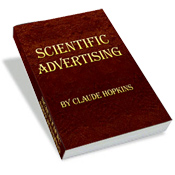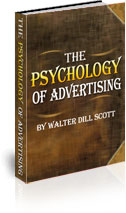1908 Kennedy must have been a hard act to follow.
But Lasker did replace him with a man who made an even greater overall contribution to the advertising world than Kennedy did.
Kennedy’s replacement was called: Claude C. Hopkins

Claude Hopkins
And what a true pioneer he proved to be.
He’s the man who inaugurated free sampling, risk-free trials, money-back guarantees, market testing, and much more.
Hopkins agreed with Kennedy on the “Salesmanship-in-Print” philosophy, but where Kennedy was a “one idea” man, Hopkins had many ideas.
Hopkins reckoned that just placing ads and seeing what happened was futile. Pure guesswork. He wanted to measure everything that he did.
And we should all be glad that he did.
Hopkins wrote only two books but both were classics. His first: “Scientific Advertising” written in 1923 contained many of his secrets that he found with his testing techniques. These secrets are still as valid today.

Scientific Advertising by Claude Hopkins
His second book, written in 1927, was an autobiography called: “My Life in Advertising.” Many regard this as the best advertising book ever written.
All top marketers regard Hopkins’ first book as their copywriting “how to” bible.
And the late advertising great, David Ogilvy, had this to say about Scientific Advertising: “Nobody should be allowed to have anything to do with advertising until he has read Scientific Advertising seven times – it completely changed my life.”
Jay Abraham, known as America’s #1 marketing wizard, had this to say: “Claude Hopkins is the master of them all. His influence has easily added over $6m to my personal income … and still counting.”
Hopkins created ad campaigns for many major US companies that are still going strongly today. Companies such as Palmolive, Pepsodent, and Quaker Oats.
One of his secret strategies for creating more turnover for his clients was that of “pre-emptive” strikes.
| Time-out: In fact, Hopkins himself never used the term “pre-emptive” but that was what he was doing. The word was used later by Rosser Reeves and also by Jay Abraham. |
By this strategy, he used to tell a story of how things were done in an industry and thus educate the customers. Any competitors could have told the same story but didn’t and whoever did so first, gained the edge.
Hopkins stated in his books that a large part of advertising done at the time was based on the concept of: “Buy My Product” or “Come Into My Store.” Lots of advertisers today make this same mistake. Are you one of them?
Customers are not fooled by this. They want to know: “What’s in it for me?”
Hopkins knew this and used this psychology to grow Van Camp’s pork and and bean business. After his research, Hopkins found that 94% of housewives were baking their own beans at home and only 6% were buying canned beans.
But Hopkins realized that everybody advertising canned beans merely stated: “Buy My Brand.” Nobody explained what the benefit of their product was.
| Time-out: John E. Kennedy also knew this. That’s why he re-published his book: “Reason Why Advertising.” He had already worked out, years before Hopkins, that you had to give your prospective customers a “reason why” they should buy your product. |
So, Hopkins ran an advertising campaign that explained how it took 16 hours to bake beans at home, and you could never make home baked beans digestible.
He talked about crispy beans on top and the mushy beans on the bottom. He also highlighted the process Van Camp’s used to select their beans, the soft water that they used, and how they made the skins less tough by removing the lime. He also emphasized the steam ovens where the beans were baked at 245 degrees in sealed containers so no flavor was lost. Then finally he offered a free sample so customers could compare.
This particular campaign became a huge success for Van Camps. Yet it was the very same process that all the manufacturers could have told. But they didn’t.
Here’s another famous story from Claude Hopkins which you may have heard of.
Schlitz Beer were ranked 5th. in their share of the market. That was, until they hired Hopkins to do his makeover.
At the time, every beer manufacturer was advocating that their brand was “pure.” But consumers thought: “who cares,” that was until Hopkins worked his magic and actually explained what was meant by “pure.”
Hopkins knew that he had to understand the whole process of beer making so he was taken on a factory tour where he was shown plate-glass rooms where beer was dripping over pipes. This, he was told, was so that those rooms filled with filtered air, so the beer could be cooled in without impurities.
Then he was shown huge and very expensive filters filled with white-wood pulp that provided a superior filtering process. The manufacturer explained how every pump and pipe were cleaned twice a day to ensure purity. Also, every bottle was sterilized not once, or even twice, but four times before being filled with beer.
The Schlitz factory was located on the shores of Lake Michigan, which at the time was not polluted and could have provided clean water, but no, Schlitz got their water from 4,000 foot deep artesian wells to ensure that the water was the cleanest and purest it could possibly be.
And at the end of his tour, Hopkins was shown into a laboratory and shown the mother yeast cell, that took 1,200 experiments to reach the required robust flavor. All Schlitz beer was developed from that original yeast cell.
Hopkins was truly amazed and asked why the company didn’t tell their customers all this. Their reply was: “because all beer manufacturers do it this way.”
And Hopkins replied: “Yes, but nobody has ever told the story.”
Hopkins’ campaign took Schlitz from that 5th. spot to equal 1st. spot in just a few months.
What Hopkins did in these two examples and all the others he created, was educate people. The same is true today. You cannot over-educate people.
Now maybe you’re still thinking, anything from as long ago as the beginning of the last century can’t possibly work today. Then think again.
| Time-out: Maybe your business operates in exactly the same way as your competitors. How do you gain an edge? Take time to write down exactly what you do. Cover your whole process from “cradle-to-grave”. For sure, you will come up with some of your own “pre-emptive” strikes. |
Do what all the top marketers do. Read, and re-read, Claude Hopkins’ “Scientific Advertising.”
1908 Walter Dill Scott produces another classic on advertising: “Psychology of Advertising.” Maxwell Sackheim said this about this classic manuscript: “The only book on advertising I read as a youth was written by Professor Walter Dill Scott of North Eastern University and was titled: “The Psychology of Advertising.” I still think it is one of the finest books ever written on the subject – and that his formula for successful advertising has never been surpassed.

Professor Walter Dill Scott’s “Psychology of Advertising”


0 Comments